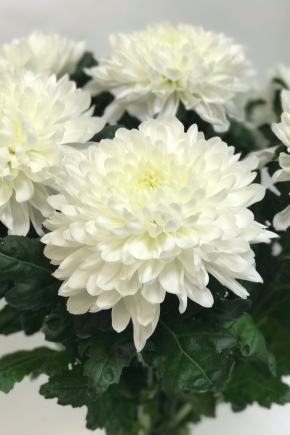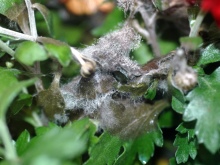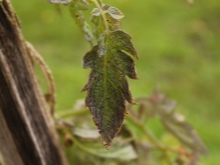Chrysanthemum "Antonov": description and recommendations for growing

Chrysanthemums over time do not lose their popularity among gardeners and florists. We especially love the Antonov variety. It was bred back in the 19th century, when these flowers were at the peak of their popularity. Modern florists and landscape designers love Antonov for its abundant and long flowering, beautiful lush flowers of different shades and for its subtle heady aroma.
These chrysanthemums are used both in mono bouquets and when composing compositions with other flowers.


Description and characteristics of the variety
Chrysanthemums belong to the Astrov family, they represent a thickened stem ending in a single flower. It is a perennial crop that tolerates low temperatures well. It grows well in almost all regions. One-headed aster "Antonov" can grow up to 150 cm. The lush bud can reach a diameter of 15 cm. The color of the petals is mainly white and cream. But florists offer a wider range of flowers, due to the coloring of the petals with special compositions with pigments.


Growing rules
Agronomists recommend purchasing chrysanthemum seedlings in specialized nurseries for growing in their own gardens and on plots. This will save you from changing the variety.
Before buying, carefully inspect the plants - pay attention to the condition of the leaves and the presence of pests. Also, agronomists do not advise buying already flowering bushes, as they may not survive the transplant.
Plant stems should be green with young shoots.

Site requirements
Chrysanthemums are light-loving plants, so choose open, well-lit areas or places with little shade for a flower garden. Avoid planting in low areas, as all water will drain there and stagnate, leading to root rot and plant death. Better to pick up flatter and higher areas.


Ground requirements.
Plant chrysanthemums in areas with light, loose soil. Light loams are also suitable, the pH of the soil should be neutral. If the soil is not loose enough and poorly drained, then expanded clay or vermiculite can be added.


Planting seedlings
Planting begins in spring or autumn. Previously, compost or humus is added to the flower bed. It is also good to add phosphate fertilizer. Grooves are cut or holes are dug on the site. Plants are buried in the soil by 20-25 cm, the distance between them should be at least 30-40 cm. Each bush is sprinkled with earth and watered in a circle with warm water.
When planting in the fall, the peduncles are first removed, as they will interfere with rooting and draw off nutrients to themselves. The optimal landing date is early September. Then the plants will have time to take root and adapt to new conditions.


Watering mode
After planting, the flower bed is watered 2-3 times a week. If the summer is rainy, then watering is reduced. After each irrigation, it is necessary to loosen the soil so that it is saturated with oxygen and moisture does not stagnate. The beds must be regularly cleaned of weeds, since the latter not only spoil the appearance, but also contribute to moisture stagnation and root decay.

Top dressing
At the beginning of the growing season, it is good to feed the plants with nitrogen. The flowers will then produce lush foliage and develop a powerful root system. At the beginning of the budding phase, phosphorus feeding is required, which will help form large buds.
And in the flowering phase, they are fed with potash fertilizers so that the buds are lush and large.


Winter care
After the end of the flowering period, the stalks of the chrysanthemums are cut, leaving 5-7 cm. A pile of earth or rotted manure is formed on the flowerbed. Then it is covered with spruce branches or sawdust. When it snows, a small mound can be poured onto the flower bed. In such a shelter, flowers hibernate until spring.


Chrysanthemum diseases
The main reason for the appearance of diseases on the bushes is the thickening of the plantings, the presence of weeds, and waterlogging of the soil. Rainy and cold summers also increase the risk of disease on bushes.
The most common diseases are as follows.
- Powdery mildew. This is a fungal disease, the characteristic features of which is a white coating on the leaves and stems, with its subsequent darkening. Darkened areas rot and dry out. If you notice the disease at an early stage, then remove all affected leaves and shoots from the plant. Then treat the flowerbed with Bordeaux mixture. You can buy fungicidal preparations in the store.
- Gray rot. The disease is provoked by high humidity and rainy weather. At first, the leaves are covered with dark spots, then they begin to rot. The same thing happens with the petals. At the first symptoms, it is necessary to treat with a fungicide, for example, "Fundazol".
- Verticillary wilting. This is a viral disease, which is characterized by yellowing of the lower leaves. The virus develops in the roots of the plant and then travels further along the stem. To combat it, biological products are used.



Pests and methods of dealing with them
The spider mite is the most dangerous pest of not only chrysanthemums, but also many plants. It is impossible to detect an insect with the naked eye, it is very small. You can only notice that plants are inhabited by a tick by the presence of a thin cobweb on the back of the leaf. Insects feed on sap from plant leaves.
First, small dry spots appear on the leaves, then they increase. Gradually, the plant begins to wither, then dry, and eventually dies if it is not rid of the tick. For processing, insecticide preparations are used. One of the well-known and available ones is Aktara. It is necessary to carry out 2 treatments with an interval of 2 weeks. And so that the pest does not populate neighboring clubs, they also need to be processed.
In addition to the spider mite, the chrysanthemum can be affected by scale insects and thrips. Treatment with "Aktara" is also suitable against them.


Measures to prevent the appearance of diseases and pests
Reduce and even eliminate the appearance of diseases and pests in flower beds correct agricultural technology and care will help.
- The correct selection of the site for planting. By choosing well-draining soils, you can minimize the risk of flower rot.
- Timely weed removal. To prevent weeds from growing in the flower bed, you can mulch the area with humus. But do not use sawdust for this, as they increase the acidity of the soil.
- Correct watering. It is necessary to exclude the ingress of moisture on the leaves and petals and water the plants at the root.
- In rainy and cold summers, carry out preventive treatments with fungicides and insecticides, since in such conditions the risk of diseases and pests increases many times.

For information on how to plant a chrysanthemum, see the next video.







































































































The comment was sent successfully.